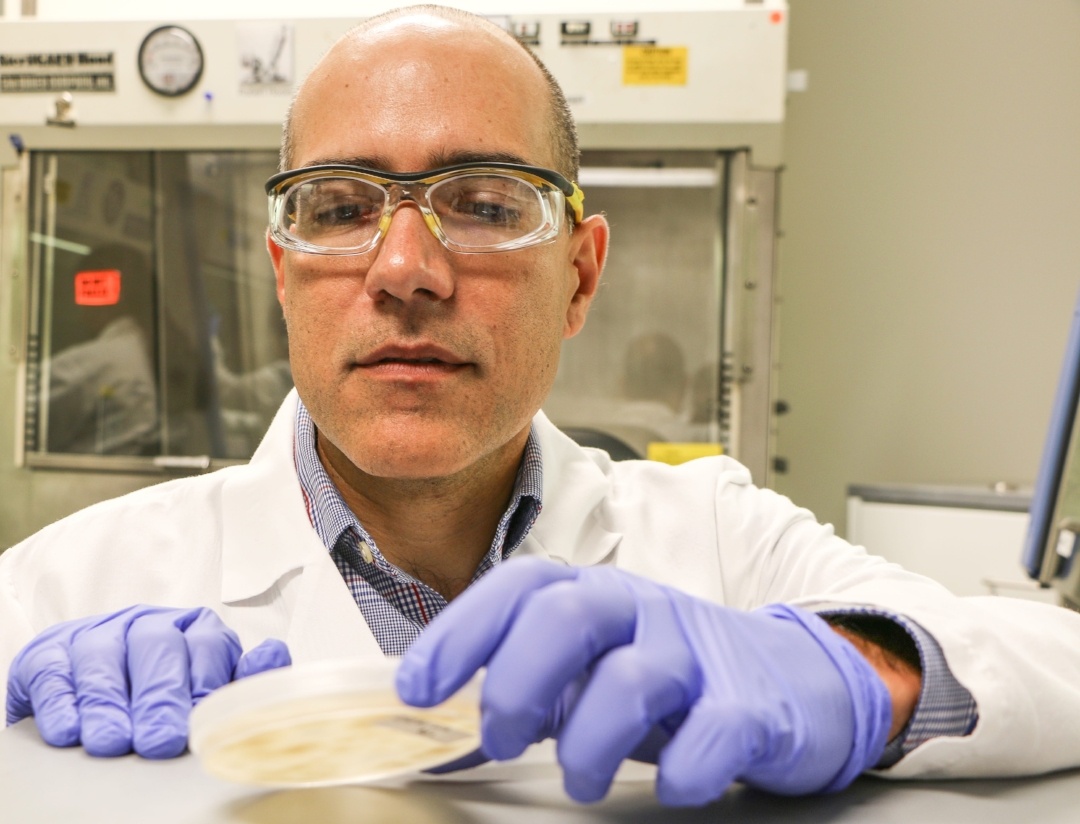Luis Marquez, senior scientist in Indigo’s Discovery department, joined us for a conversation on everything from evolutionary change in coral reef communities to the ancient “ah-ha” moment that gave rise to the wheat varieties of today. At one point, Luis paused our discussion of adaptive leaps, one of his areas of expertise and a topic on which he has authored many papers (see below), to recount a harrowing episode. While diving in Australia’s Great Barrier Reef, his boat suffered sudden “structural failure,” took on water, and capsized thirty miles off the coast. One marathon session of treading water and a helicopter rescue later, Luis had experienced a change of heart and chosen to shift his studies from the high seas to more stable ground—a decision that directed his attention towards in-plant microbes and ultimately landed him at Indigo.
TO START, CAN YOU TELL US A BIT ABOUT YOUR BACKGROUND?
I have a background in molecular ecology. I was always interested in understanding adaptive leaps: how organisms can adapt quickly to new environments. One way they do this is by combining very different genomes. For my PhD thesis, I worked with hybridizing corals in the Australian Great Barrier Reef. In many ways, corals resemble more plants than animals: They stay in the same place, they photosynthesize, and, just like plants, they hybridize, and their hybrids can populate environments where both parental species are rare.
For my postdoc, I studied a virus that infects an endophytic fungus essential for the plant that it colonizes to survive in geothermal soils in Yellowstone National Park. These plants can grow at temperatures of 150˚ Fahrenheit in the soil, a feat they accomplish by establishing symbiosis with the fungus. The upper limit of temperature tolerance for vascular plants is around 45˚ Celsius (around 115˚ Fahrenheit), so this is way above that limit. This constitutes a dramatic adaptive leap, enabled by the combined action of three genomes.
WHAT BROUGHT YOU TO INDIGO?
When I finished that postdoc, I went back to Venezuela, my native country, and worked as a principal investigator in a public biotech institute. My students and I were interested in drought stress tolerance, so we isolated endophytes from plants growing in deserts or very dry areas. We published a paper in 2012 showing the diversity of different endophytic fungi in grasses growing in these very dry environments on the coast of Venezuela. That study helped inform some of the work that we’ve been doing here at Indigo.
WHAT PROMISE DOES AGRICULTURE TECHNOLOGY HOLD FOR LATIN AMERICA?
Yes, of course there are great opportunities, simply because the amount of investment in research is much smaller than in the U.S. Latin America is growing very rapidly and there is great demand for agricultural products. Thus, there is fertile ground for ag-tech to flourish. Having said that, there are many good researchers in places like Brazil who have been working on these technologies for a while now, and we are looking for opportunities to collaborate with them.
WHAT ARE YOUR PRIMARY RESPONSIBILITIES AT INDIGO?
I work within the Discovery department. I lead a small group within that department that is called “Microbial Science Resources.” As the name implies, we serve as a resource for other teams. We participate in some of the activities that are directly associated with the pipeline of production, but we also develop new projects: new assays to serve the pipeline or completely new technologies.
WHAT DO YOU FIND MOST REWARDING ABOUT YOUR WORK HERE?
I would say the interaction with young people like yourself. Listening to ‘young minds’ and their new ways of looking at things is, for me, the most rewarding. At Indigo, we have a lot to discover, so we are open to ideas coming from everywhere within the company—and outside; we are always looking to collaborate with academia and other companies.
The best of our work is in front of us. I’m sure that Indigo will show many advances in the years to come. We are just getting started, so I’m very excited to see what the future of this company is going to be.
WHAT ARE SOME OF THE BIGGEST CHALLENGES YOU CONFRONT ON A REGULAR BASIS?
Time! There’s never enough time during the day to do everything we want to do. It’s very exciting and, as you know, very fast-paced, so sometimes it’s hard to keep up.
WHAT DO YOU LIKE TO DO OUTSIDE OF WORK?
I have two kids; they are 8 and 11, so they are involved in a lot of activities. Most of my time outside of the company, I spend it with my family. My wife is a scientist, too. She works at MIT, at the Sea Grant college program that’s increasing ocean literacy within the university but also within high schools. Her research focuses on ocean acidification.
WHAT'S YOUR SPIRIT VEGETABLE?
I would say wild wheat—Emmer, which is the ancestor of wheat. I think it’s fascinating the way in which that little plant inspired the development of agriculture, and how ancient people recognized that they could improve those little grains that produced very little starch. People started crossing them to get larger grains, and eventually crossed different species to come up with modern wheat. Thus, combining different genomes allowed our adaptive leap into civilization.



